2018 VOLKSWAGEN T-ROC rims
[x] Cancel search: rimsPage 177 of 502

If the front brake pads are checked, the rear brake pads should be checked at the same time. A
visual check of the thickness of all brake pads should be carried out regularly by checking the brake
pads through the openings in the rims or from the underside of the vehicle. If necessary, remove the
wheels to carry out a comprehensive check. Volkswagen recommends using a Volkswagen
dealership for this purpose.
Driving a loaded vehicle
For good vehicle handling when driving a loaded vehicle, please observe the following:
Stow all items of luggage securely Stowing luggage and loads
Accelerate particularly cautiously and carefully.
Avoid sudden braking and driving manoeuvres.
Brake earlier than in normal driving.
If applicable, observe the information concerning the roof carrier Roof carrier
WARNING
Moving loads can severely impair the vehicle's stability and driving safety which could cause
accidents and serious injuries.
Secure items properly so they cannot slide about.
Use suitable lashing or securing straps when securing heavy objects.
Securely engage the rear seat backrests.
Driving with an open boot lid
Driving with an open boot lid is particularly dangerous. All objects and the open boot lid must be
secured properly. Take the appropriate measures to reduce the amount of poisonous exhaust fumes
that could enter into the vehicle.
WARNING
Driving with an unlocked or open boot lid can cause serious injuries.
Always drive with the boot lid closed.
Always stow all items in the luggage compartment securely. Loose objects can fall out of the luggage
compartment and injure other road users.
Always drive especially carefully and think ahead.
Page 271 of 502

NOTICE
Park Assist uses parked vehicles, the kerbs and other objects as guidance. Make sure that the tyres
and wheel rims are not damaged when parking the vehicle. If necessary, stop the parking procedure
in good time to prevent damage to the vehicle.
Prerequisites
First read and observe the introductoryinformation and safety warnings
The following prerequisites must be met for driving into and out of parking spaces:
The traction control system (TCS) must be switched on Brake support systems
Distance: maintain a distance of 0.5 2.0 metres when driving past the parking space.
The parking space must have at least the dimensions required by Park Assist.
Speed when driving past the parking space (for parking spaces parallel to the road): not above
40 km/h (25 mph).
Speed when driving past the parking space (for parking spaces perpendicular to the road): not above
20 km/h (12 mph).
Maximum speed: 7 km/h (4 mph). An automatic braking intervention can take place when driving
into a parking space.
No trailer is connected electrically with the factory-fitted towing bracket Notes on towing a
trailer
The parking manoeuvre can be continued after the automatic brake intervention.
The automatic braking intervention takes place a maximum of once per parking manoeuvre. The
parking manoeuvre will be cancelled if a speed of approximately 7 km/h (4 mph) is exceeded again.
WARNING
Do not let the automatic braking intervention triggered by Park Assist tempt you to take any risks
while driving. The system is not a substitute for the full concentration of the driver.
Park Assist has system-related limitations. In some situations, automatic braking intervention may
function only in a limited way or not at all.
You should always be prepared to brake the vehicle yourself.
The automatic braking intervention is ended after approximately 1.5 seconds. Depress the brake
pedal of the vehicle yourself following the automatic braking intervention.
Looking for a parking space
Page 300 of 502
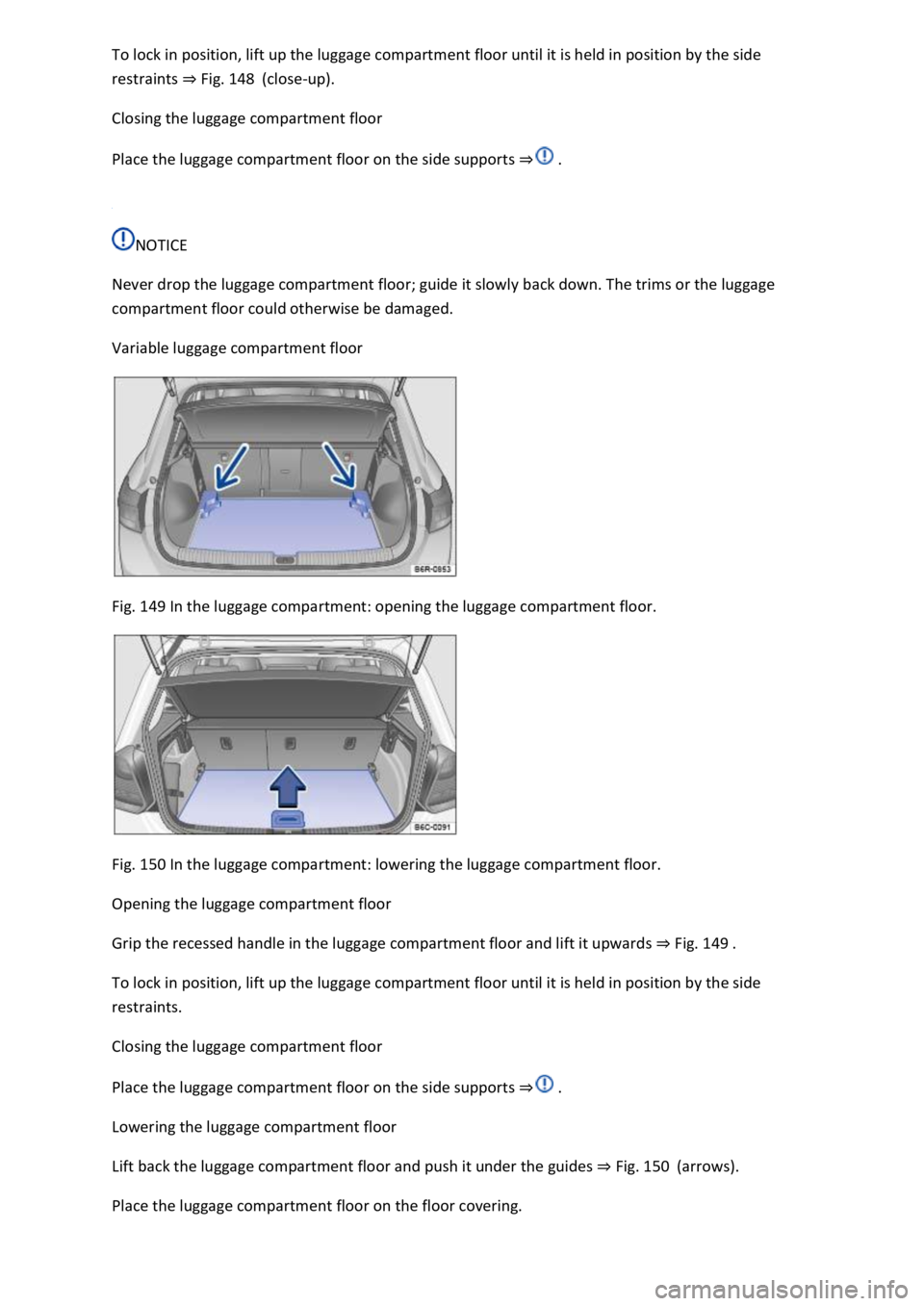
ment floor until it is held in position by the side
restraints Fig. 148(close-up).
Closing the luggage compartment floor
Place the luggage compartment floor on the side supports
NOTICE
Never drop the luggage compartment floor; guide it slowly back down. The trims or the luggage
compartment floor could otherwise be damaged.
Variable luggage compartment floor
Fig. 149 In the luggage compartment: opening the luggage compartment floor.
Fig. 150 In the luggage compartment: lowering the luggage compartment floor.
Opening the luggage compartment floor
Grip the recessed handle in the luggage compartment floor and lift it upwards Fig. 149
To lock in position, lift up the luggage compartment floor until it is held in position by the side
restraints.
Closing the luggage compartment floor
Place the luggage compartment floor on the side supports
Lowering the luggage compartment floor
Lift back the luggage compartment floor and push it under the guides Fig. 150(arrows).
Place the luggage compartment floor on the floor covering.
Page 301 of 502
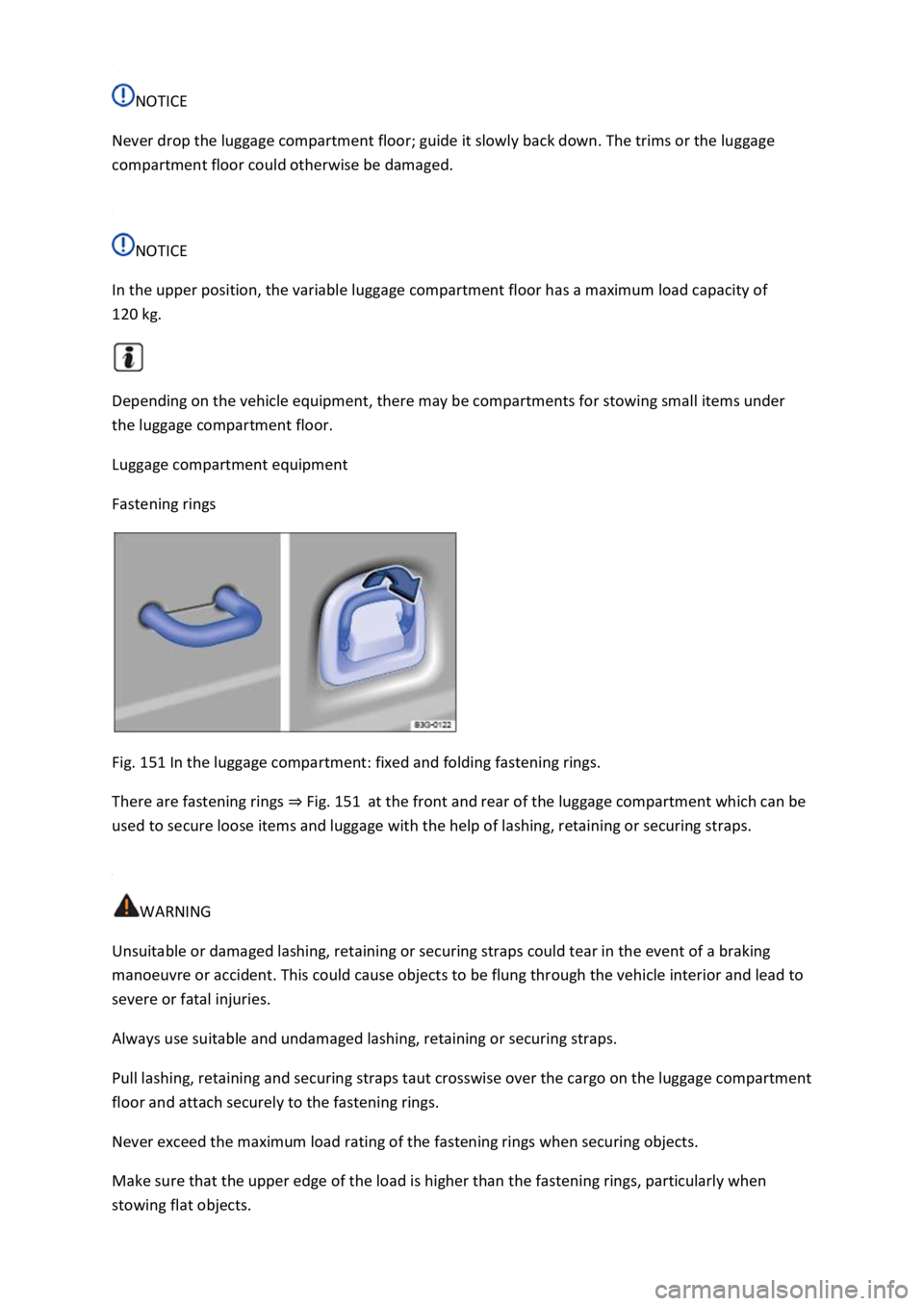
NOTICE
Never drop the luggage compartment floor; guide it slowly back down. The trims or the luggage
compartment floor could otherwise be damaged.
NOTICE
In the upper position, the variable luggage compartment floor has a maximum load capacity of
120 kg.
Depending on the vehicle equipment, there may be compartments for stowing small items under
the luggage compartment floor.
Luggage compartment equipment
Fastening rings
Fig. 151 In the luggage compartment: fixed and folding fastening rings.
There are fastening rings Fig. 151at the front and rear of the luggage compartment which can be
used to secure loose items and luggage with the help of lashing, retaining or securing straps.
WARNING
Unsuitable or damaged lashing, retaining or securing straps could tear in the event of a braking
manoeuvre or accident. This could cause objects to be flung through the vehicle interior and lead to
severe or fatal injuries.
Always use suitable and undamaged lashing, retaining or securing straps.
Pull lashing, retaining and securing straps taut crosswise over the cargo on the luggage compartment
floor and attach securely to the fastening rings.
Never exceed the maximum load rating of the fastening rings when securing objects.
Make sure that the upper edge of the load is higher than the fastening rings, particularly when
stowing flat objects.
Page 334 of 502
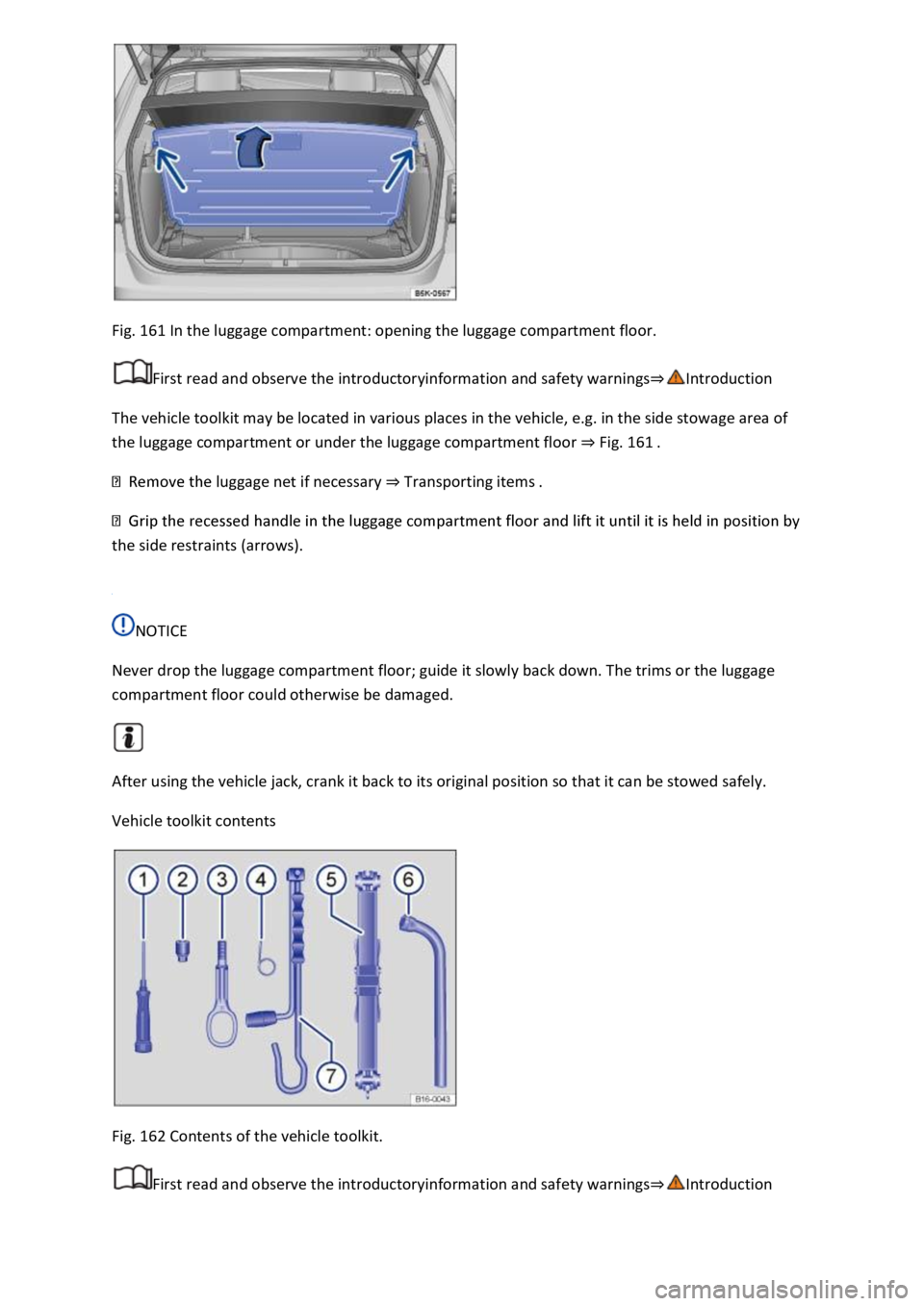
Fig. 161 In the luggage compartment: opening the luggage compartment floor.
First read and observe the introductoryinformation and safety warnings
The vehicle toolkit may be located in various places in the vehicle, e.g. in the side stowage area of
the luggage compartment or under the luggage compartment floor Fig. 161
luggage net if necessary Transporting items
the side restraints (arrows).
NOTICE
Never drop the luggage compartment floor; guide it slowly back down. The trims or the luggage
compartment floor could otherwise be damaged.
After using the vehicle jack, crank it back to its original position so that it can be stowed safely.
Vehicle toolkit contents
Fig. 162 Contents of the vehicle toolkit.
First read and observe the introductoryinformation and safety warnings
Page 335 of 502
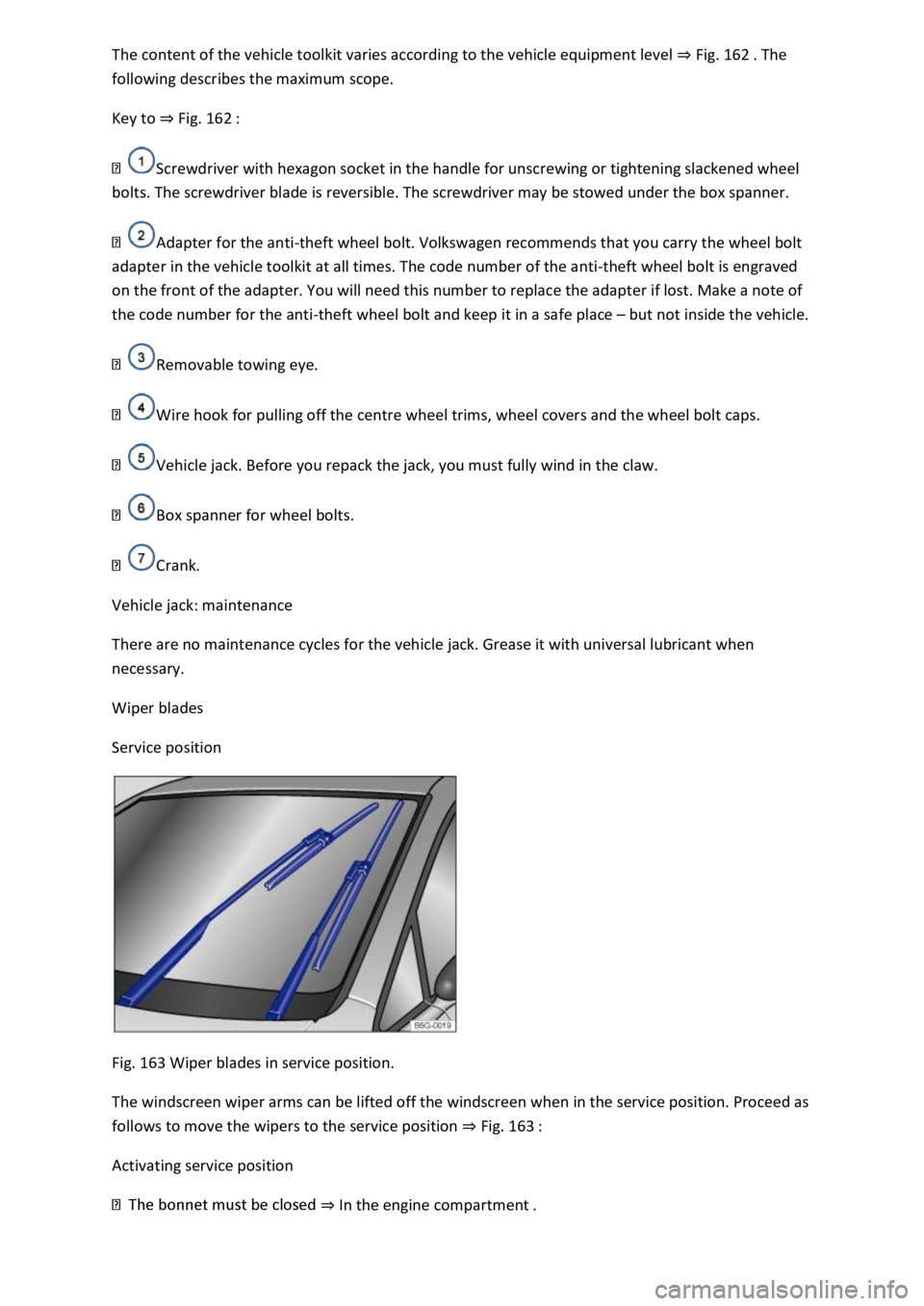
Fig. 162
following describes the maximum scope.
Key to Fig. 162
Screwdriver with hexagon socket in the handle for unscrewing or tightening slackened wheel
bolts. The screwdriver blade is reversible. The screwdriver may be stowed under the box spanner.
Adapter for the anti-theft wheel bolt. Volkswagen recommends that you carry the wheel bolt
adapter in the vehicle toolkit at all times. The code number of the anti-theft wheel bolt is engraved
on the front of the adapter. You will need this number to replace the adapter if lost. Make a note of
the code number for the anti-theft wheel bolt and keep it in a safe place but not inside the vehicle.
Removable towing eye.
Wire hook for pulling off the centre wheel trims, wheel covers and the wheel bolt caps.
Vehicle jack. Before you repack the jack, you must fully wind in the claw.
Box spanner for wheel bolts.
Crank.
Vehicle jack: maintenance
There are no maintenance cycles for the vehicle jack. Grease it with universal lubricant when
necessary.
Wiper blades
Service position
Fig. 163 Wiper blades in service position.
The windscreen wiper arms can be lifted off the windscreen when in the service position. Proceed as
follows to move the wipers to the service position Fig. 163
Activating service position
In the engine compartment
Page 395 of 502

Tyre Pressure Loss Indicator. In the event of a malfunction, the indicator lamp will flash for 65
seconds and then light up continuously. However, the indicator lamp will go out when the road
conditions or driving style change.
Useful information about wheels and tyres
Introduction
This chapter contains information on the followingsubjects:
Handling wheels and tyres
Wheel rims and wheel bolts
Tyre pressure
Tread depth and wear indicators
Tyre damage
Spare wheel or temporary spare wheel
Tyre lettering and tyre type
Maximum load and speed range for tyres
Winter tyres
Snow chains
The tyres are the most heavily loaded and most underestimated parts of a vehicle. Tyres are very
important as the narrow tyre contact surfaces are the only contact between the vehicle and the
road.
The service life of tyres is dependent on tyre pressure, driving style, handling and correct fitting.
WARNING
New tyres or tyres which are old, worn down or damaged cannot provide full vehicle control and
braking efficiency.
injuries.
s must be fitted with radial tyres of the same type, size (rolling circumference) and
the same tread pattern.
particularly carefully for the first 600 km in order to prevent accidents and serious injury.
the tyre pressure is too low, it is possible that the tyre temperature will increase to such an extent
when driving that the tread peels off and the tyre bursts.
Page 396 of 502
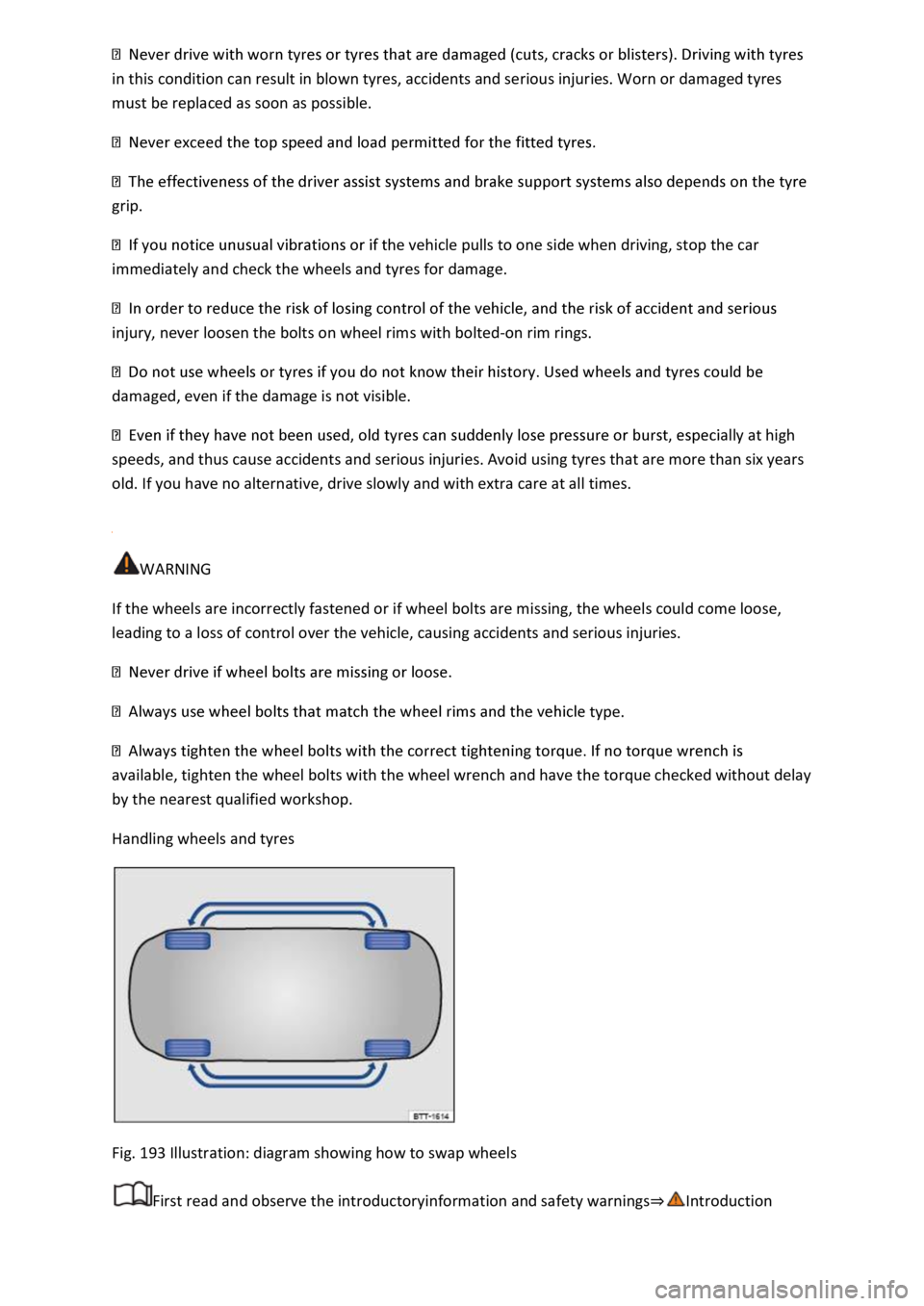
must be replaced as soon as possible.
grip.
he vehicle pulls to one side when driving, stop the car
immediately and check the wheels and tyres for damage.
injury, never loosen the bolts on wheel rims with bolted-on rim rings.
damaged, even if the damage is not visible.
ally at high
speeds, and thus cause accidents and serious injuries. Avoid using tyres that are more than six years
old. If you have no alternative, drive slowly and with extra care at all times.
WARNING
If the wheels are incorrectly fastened or if wheel bolts are missing, the wheels could come loose,
leading to a loss of control over the vehicle, causing accidents and serious injuries.
type.
available, tighten the wheel bolts with the wheel wrench and have the torque checked without delay
by the nearest qualified workshop.
Handling wheels and tyres
Fig. 193 Illustration: diagram showing how to swap wheels
First read and observe the introductoryinformation and safety warnings